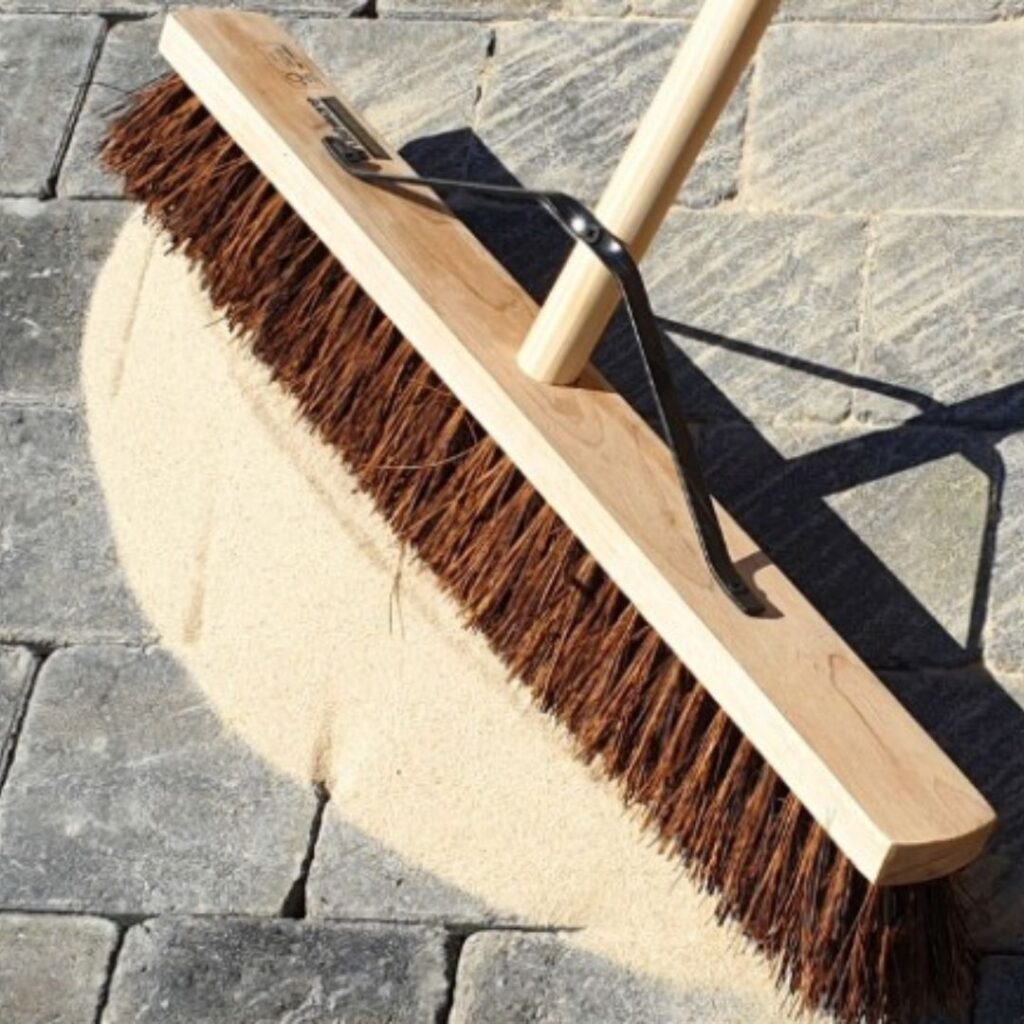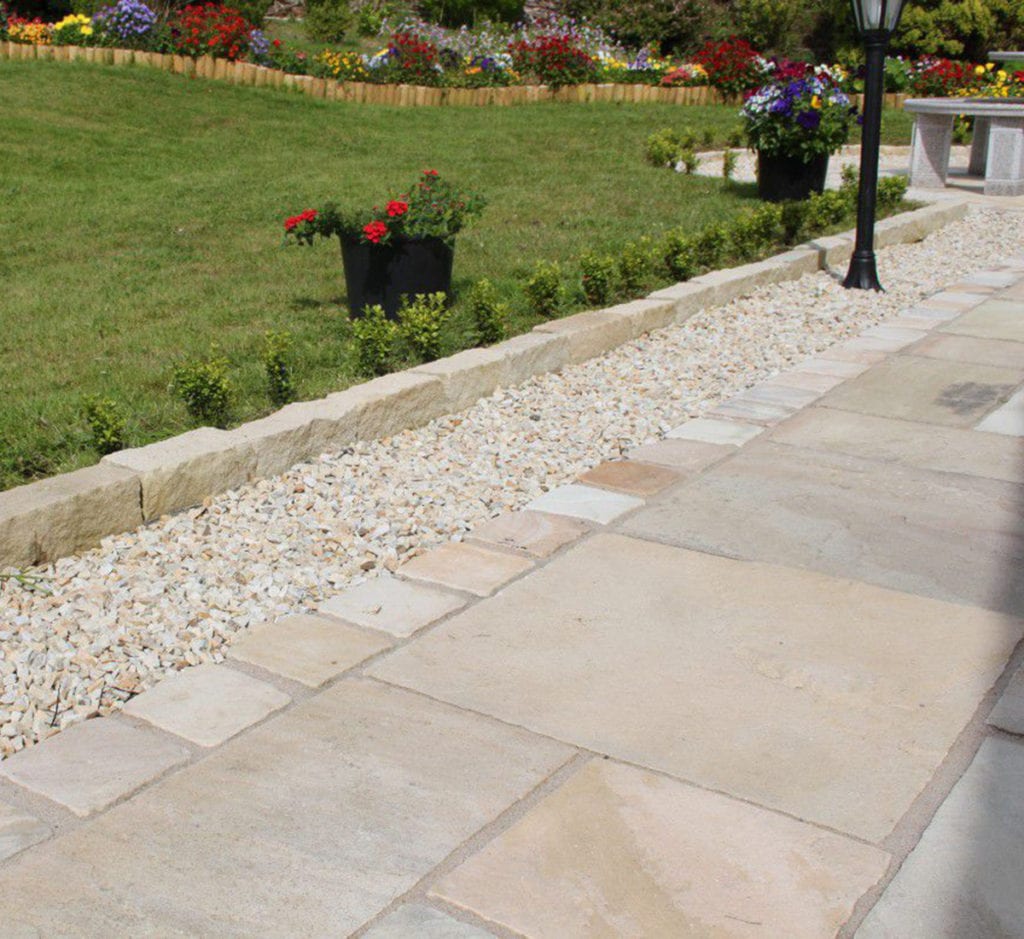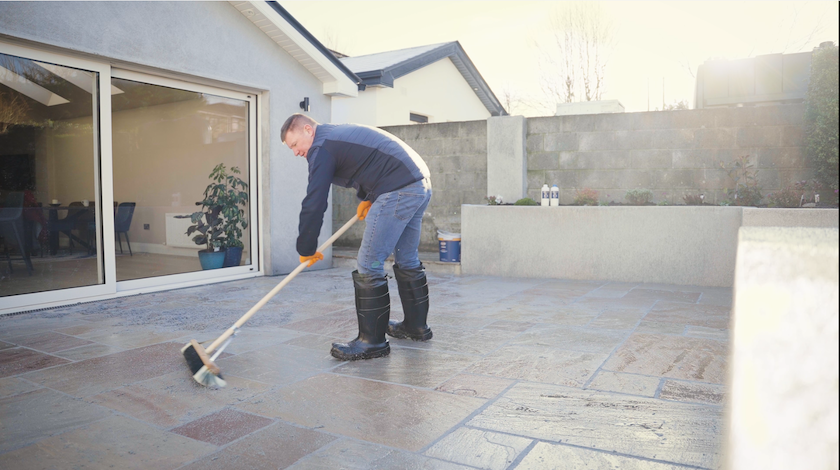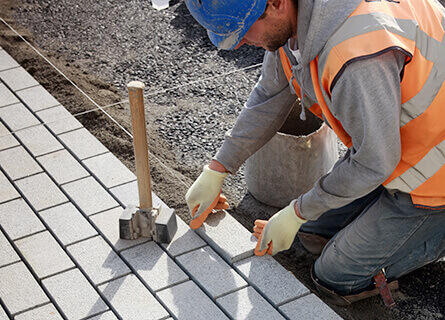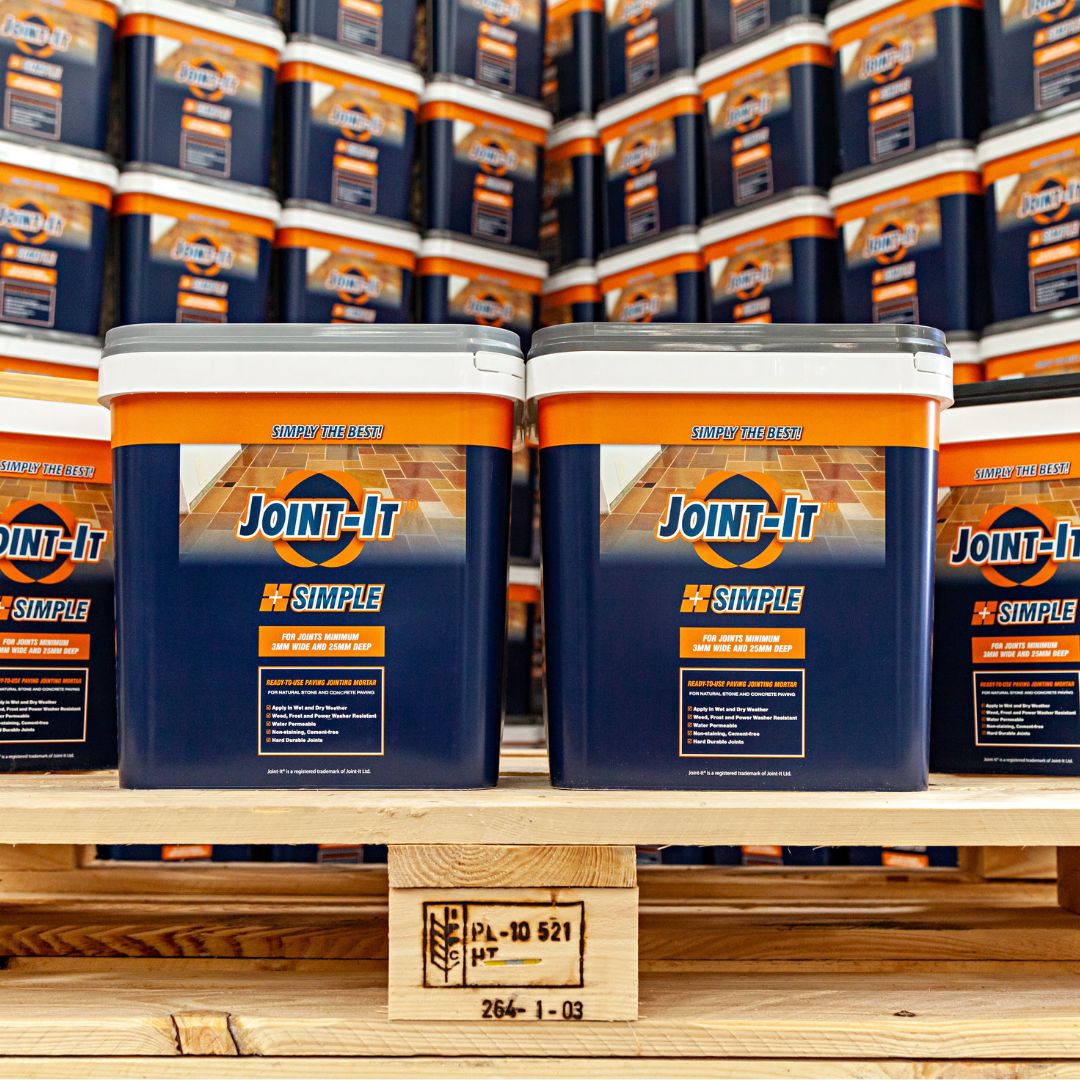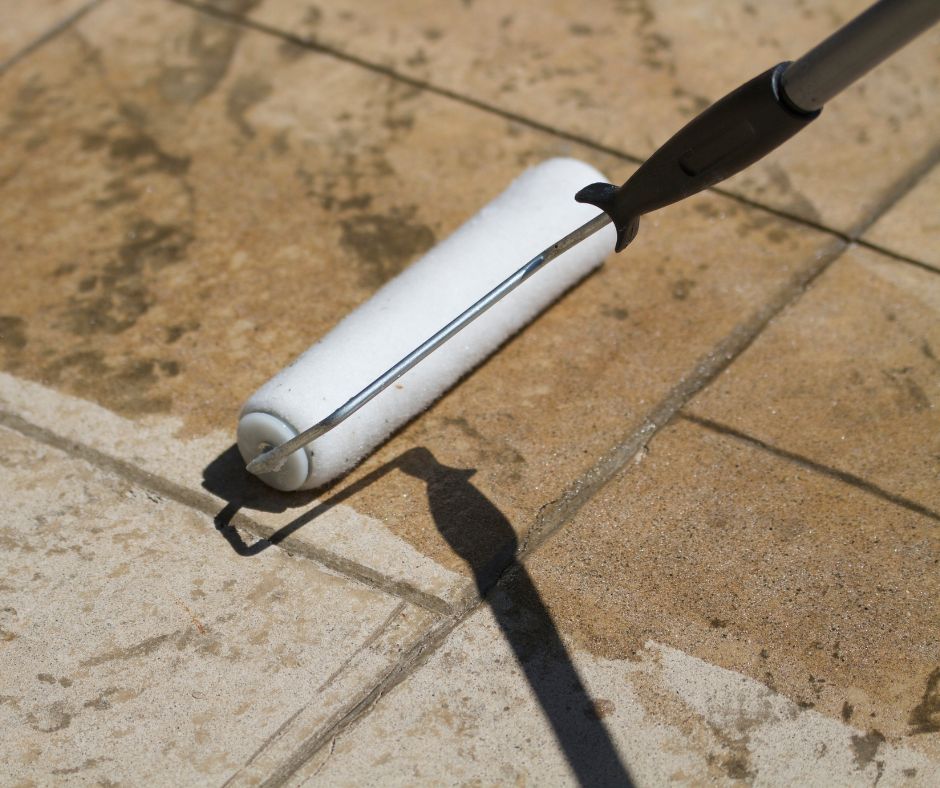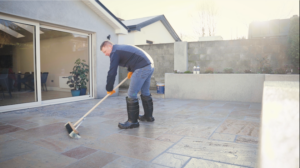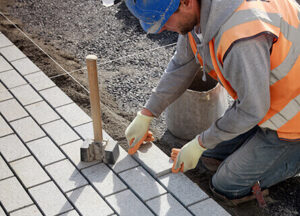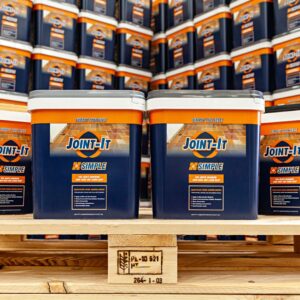When using a permeable brush-in grout or polymeric sand for pointing pavers, you may have the option of applying the jointing compound via a wet grouting or dry grouting method. Find out more about these two application methods for sand-based grouts and how to choose the best approach for your paving project.
Brush-in grouts are cost-effective choices for pointing patios, very easy to use, and are often available in a variety of colour options to complement all the many different shades of natural or manmade slabs.
As permeable formulas, brush-in grouts are often used for SUDS-compliant patios. As long as paving stones are laid on a permeable bed, these sand-based mortars will allow rainwater to infiltrate into the ground below.
Dry grouting vs wet grouting method
With some brush-in grouts like PremJoint and EASYJoint, you can choose either the dry grouting or wet grouting methods of installation.
These methods are used to fill the gaps or joints between tiles, paving slabs, setts or natural stones, mostly in pathways and patios. With some brush-in grouts like PremJoint, extra steps can be taken to make the project strong enough to withstand vehicles.
The dry grouting method
The dry grouting method is sometimes known as dry jointing or dry sanding. A mixture of dry material, typically containing a combination of sands, fine aggregates and cement, is used to point a patio. Dry grouting relies on natural moisture adding water to the formula’s cement content after the formula has been installed.
Using a broom or brush, the mixture is dry brushed into the joints until the gaps are filled. Once the joints are full, excess grout is swept away and the joints may be ‘struck off’ to finish. As no water is typically required there is a low risk of surface stains as long as the weather is dry.
Dry grouting is an easy-to-install grouting method that does not require the use of water and extra tools or equipment. However, some contractors consider dry grouting to be less durable than the wet grouting method using the same formula or other wet grouting techniques like slurry grouting.
The wet grouting method
With the wet grouting method for brush-in grouts, the same formula is used as in dry grouting but with the addition of lots of water during the installation process.
Many brush-in grouts made from polymeric single compounds can be applied using the wet grouting method by adding water before, during and after application. Always check the product first to see whether this is recommended.
The main benefits of wet grouting is that the formula will be much easier to manipulate into the joints. The formula is simply worked into the joints, often using a rubber squeegee, and achieves better compaction than with dry grouting.
This is not only a plus for easing installation. When the material is moved deeper into the joints, this helps to protect the pavers from oils and from stains developing.
Depending on the quality of the formula, the results from wet grouting often provide a longer lasting patio with mortar that is robust enough to deter cracks, slab stains and weeds.
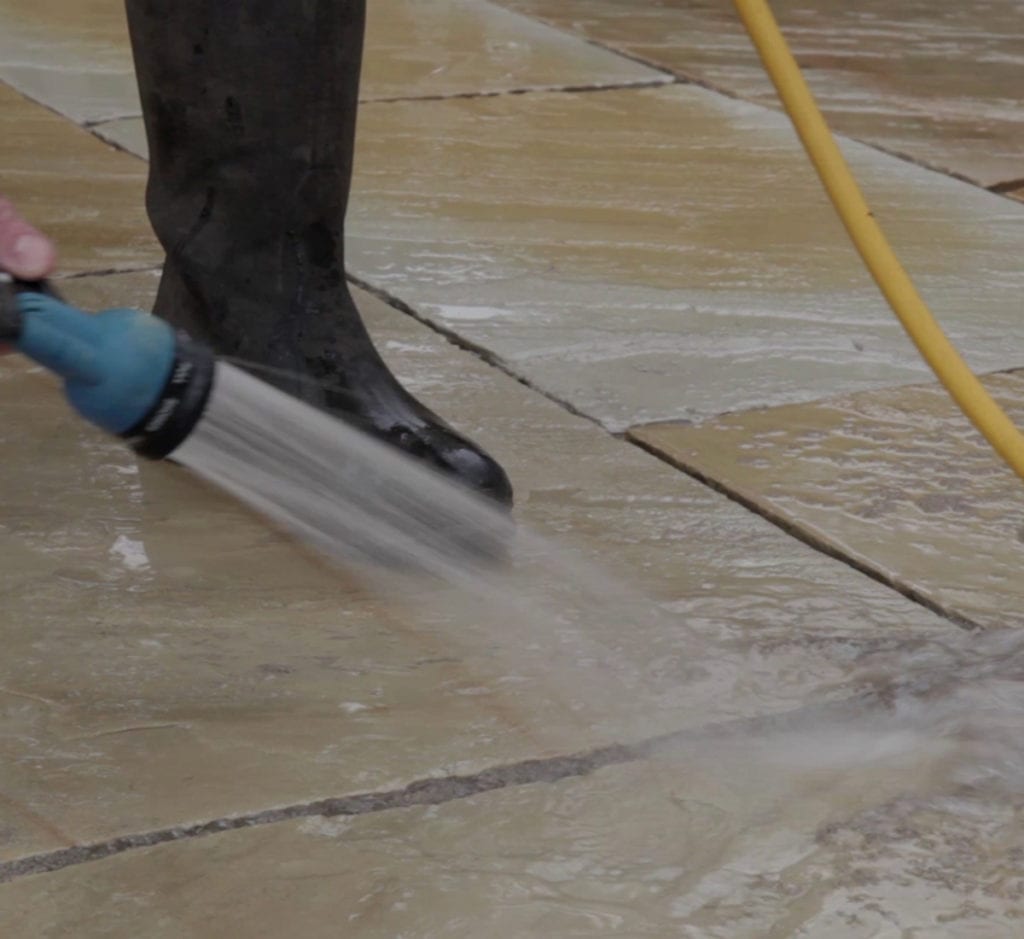
Whether you use a dry or wet grouting method depends on a number of factors.
Before we cover these, we must advise to always check the manufacturer’s instructions before choosing and installing a new product. At The Paving Experts, we’re here to offer advice for your paving project – call us on 0330 122 1025.
When to use the wet grouting method
Most brush-in grouts are recommended to apply using the wet application method as doing so provides a much stronger finish and a reduced risk of staining.
An important factor for wet grouting with a sand-based grout: it must be installed on top of a permeable bedding mortar.
If the bedding layer is impermeable, you must apply the grout using the dry grouting method mentioned below.
With a fully permeable system, water can flow freely through the patio, avoiding puddling and topping up the water table. In front garden projects of over 5 square metres, installing a fully permeable system means you may be able to avoid requiring planning permission.
When to choose dry grouting
Most contractors will opt to apply brush-in grouts using a wet application method mentioned above. But at times you may prefer to opt for the dry method.
Colder temperatures
Unlike the wet method, dry mixes can still be applied at temperatures below 3ºC. You must not use the wet method during cold spells as the additional water applied is likely to freeze and expand in the joints.
Always check the technical datasheet for the minimum working temperature. Be aware that ground temperature is always slightly cooler than outdoor temperature.
Even though you can still use the dry method at temperatures close to freezing, you still need to ensure the ground is not frozen.
Impermeable bedding materials
Another big reason for using a dry grouting method for polymeric formulas is if the bedding layer is impermeable.
Wet grouting is not recommended when an impermeable bedding mortar has been installed or if the area has poor drainage.
In both these instances, water applied using a wet grouting method will stay within the joints instead of freely draining away. With water still present, the mortar will not harden and cure. You can avoid these issues by using a dry grouting method.
Grouts like PremJoint can be used on paved driveways to withstand vehicles. However, in this instance you must install an impermeable bedding material for extra strength and therefore use the dry grouting method.
Important considerations for dry grouting
There are things you must be aware of before dry grouting.
Check the weather forecast
With some polymeric formulas like ProJoint PolySweep and traditional 3:1 dry sand to cement mixes that are applied using dry grouting, you must ensure there is no risk of rainfall for at least 12 hours after installation. Use a tarpaulin if there is a slight risk of rain. Any water will cause the mixture to stick on the pavers and will likely result in stains.
When using brush-in grouts like PremJoint, EASYJoint or ProJoint Fusion using the dry grouting method, you should apply a light misting of water to the area before application to prevent staining.
Fully compact the joints
When dry grouting, it can be difficult to sufficiently fill the joints purely because of the fluffiness of the formula without any water present.
You can combat this by compacting the sand into the joints using the blade of a pointing trowel or a striking tool. Apply more formula before compacting again and repeat until the joints are completely filled.
A sealant may be necessary
With some brush-in grouts, like EASYJoint, a sealant is advised when using the dry grouting method.
Two to three days before installing EASYJoint, you must seal all five sides of each slab (the top and four edges).
Sealants are always recommended for use with sensitive stones such as black limestone, granite, slate and polished sandstone – regardless of the grouting method and your choice of grout.
Recap on the dry grouting method
As a recap, important things to be aware of before dry grouting are:
- With some mixes, dry grouting is only practical during very dry weather
- Some dry mixes should not contain any water to avoid spots and stains
- Always use dry grouting after installing an impermeable bedding layer
- Always work the dry mix fully into the joints and compact with a tool
- Dry grouting is best for smooth pavers with regular joints (not riven flags)
- Except with a quality grout, dry grouting is prone to cracking and weeds
Can I use a traditional sand to cement mix?
A traditional 3:1 sand to cement mortar mix can be used as a brush-in grout. However, installing this simple mix does make the joints prone to weed growth.
When installing a traditional mortar using the dry method, you must be aware that there is a small window of opportunity for installation. With a simple sand to cement mix, dry grouting should be applied during dry weather to avoid any staining.
Benefits of polymeric brush-in grouts
Polymeric sand is a specially formulated brush-in grout made of a blend of fine sand, quartz, silica sand, together with natural or synthetic additives and binders. Portland cement is often included in these formulas.
Buying off-the-shelf polymeric sand, such as Premjoint, EASYJoint or PolySweep, can offer a more robust grouting mix that can withstand weathering and is a deterrent to weed growth, mortar cracks and staining.
Recap on wet vs dry grouting
As a summary, when deciding whether to use the wet or dry grouting method, you should consider:
- Permeable bed? Use wet grouting method for ease and extra strength
- Impermeable bed or poor drainage? Always use dry grouting method
- Wet grouting method will help to minimise oil residues sitting on the pavers
- Wet grouting method flushes the product to the bottom of each joint
- Temperature below 3ºC? Choose dry grouting or postpone application
- Establish whether you need to apply a sealant (certainly for sensitive stones)
As mentioned earlier, check the technical datasheet to see which grouting method is advised and any further recommendations.
Explore more popular grouting methods
Aside from dry or wet grouting with a brush-in mix, there are other grouting methods to choose from.
Slurry grouting with cement-based formulas is a popular option for long-lasting patios, pathways and driveways. Using products like Flowpoint rapid-setting grout, Fuga-Pave Flex CH grout or Larsen FMJ, these types of formulas can last decades when applied correctly. Read our guide on how to apply Flowpoint as an example.
Single-part or two-part epoxy resin grouts are other robust options to consider. Although mostly used by professional landscapers, epoxy grouts like Nexus ProJoint can be installed by anyone – even those who are grouting a patio for the first time.
If you need any extra advice or a point in the right direction, our family-run team would be happy to help. Give us a call on 0330 122 1025.

